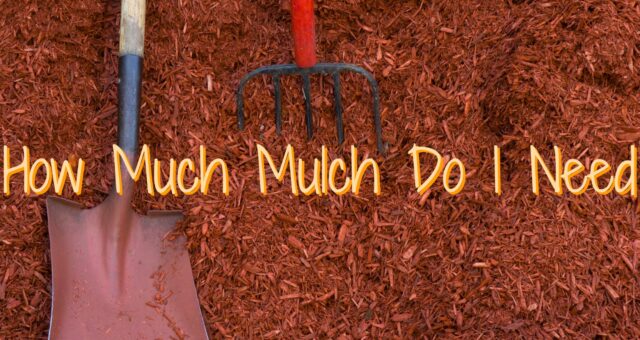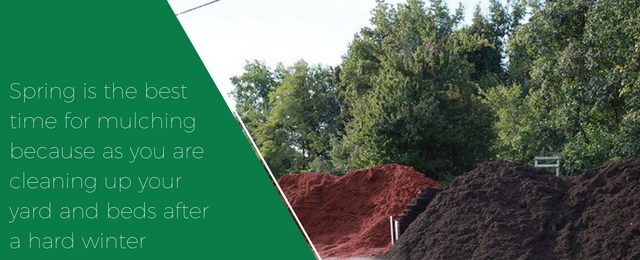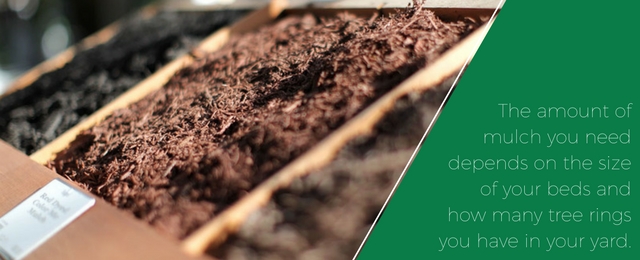
How Much Mulch Do I Need
Well, it is that time of year again. The days are growing longer and the trees and shrubs are starting to bud. Now is the time we start to think about enjoying the great outdoors again as the sun starts to warm things up. Prior to it getting too hot out, it is always a good time to do a thorough spring clean up of your yard. Reference our spring yard cleanup tips to learn how to properly prepare your lawn. Along with that clean up, a fresh layer of mulch always says spring is here. So, today we want to address many of the questions we get that involve Spring Mulch.
Why Should I Mulch?
The proper mulching of your landscape beds will not only give your property a crisp, clean, and manicured look but, it will also drastically reduce the amount of time spent weeding, watering and fighting pests later in the season. Mulching also helps with erosion control as well as keeping dirt from splashing up on your flowers, home, and hardscape features when it rains.

Benefits to Mulching
- Adds nutrients to the beds to help with healthy plant growth
- Helps to reduce weed germination and growth
- Helps retain soil moisture, protecting plants from drying out quickly
- Reduces erosion
- Moderates soil temperature fluctuations
- Protects plant roots from winter
- Mulch will give beds a uniform, well-cared for look
When Should I Mulch?
Spring is the best time for mulching because as you are cleaning up your yard and beds after a hard winter, it provides the perfect opportunity to start spring off on the right foot. It will keep your plant and flower beds protected from excessive weeds and will protect your plants from the heat of summer. Fall is also a good time to freshen up your mulched areas as you clean up the beds prior to winter. The layer of mulch also helps to protect the roots of your plants from the winters freezing temps.
How To Properly Mulch
Basically, there are 8 steps you should follow to properly care for your beds and mulch is the final step. You can skip some of the suggested steps in the spring, but in the long run, you will find yourself doing extra work later.
- Kill Weeds
Spray all weeds with weed killer 1 to 2 weeks prior to mulching. This allows weeds to completely die, making them much easier to pull. Be sure NOT to spray desirable plants, as weed killers are non-selective. - Trim Trees and Bushes
Because of the pruning your trees and bushes can be messy it is a good idea to prune them prior to applying a fresh layer of mulch. That way you will get that fresh clean look you get after your beds have been mulched. - Clean Out Mulch Beds
Remove all dead leaves, weeds, and trimmings with a rake. - Cultivate
Use a roto-tiller or hand cultivator to loosen any compacted soil or mulch. This allows moisture and air to pass through the mulch easier. - Edge Your Beds
Landscapes with clean edges enhance the appearance and give it a professional look. Use an edging shovel or power edger to accomplish this. Tip: Use your garden hose as a guide to create nice flowing curves. - Rake Smooth
Use a stiff rake, such as a mud rake, to smooth all surfaces to be mulched. Otherwise, your mulch will look lumpy. - It’s Time to Mulch
Using your hands or a rake apply new mulch over the cultivated mulch or soil. Spread evenly to 2-inches thick, more or less, depending on budget and preference. - Apply a Pre-Emergent
This is the time to prevent weed seeds. Apply the pre-emergent like PREEN after mulching. A second application later further ensures protection from weed seeds. When complete, water to activate pre-emergent, moisturize mulch and settle it into place.
How Much Mulch Do I Need?

Well, that depends on the size of your beds and how many tree rings you have in your yard. First, start off by measuring your beds. We need to determine the approximate length and width of your bed areas. I always feel it is better to overestimate the size of my bed than to under /estimate them. For me, I know that my walking pace is approximately 3’ long so I will walk the length and width of the bed. Then, I will multiply those 2 numbers. So if my bed is 20’ long and 5’ wide then the area of my bed is 100 square feet. One cubic yard of mulch covers 100 square feet at three inches deep. There are 27 cubic feet in a yard. Most of the mulch bags we sell are 3 cubic foot bags so there are (9) 3 cubic foot bags in a yard of mulch. If math isn’t your strong suit there are also many handy mulch calculators available online.
Mulch Calculator
What Types Of Mulch Do We Sell?
We sell a variety of bulk mulch, some of which include: Shredded Mulch, Brown Dyed Mulch, Black Dyed Mulch and Red Dyed Mulch. You can shop these products and more both in store and online. All of these mulches are made from natural wood products. They are typically double ground for a smooth consistency. We also make a triple ground product which just means it is ground a third time so that the end result is a finer ground product. Many times triple ground mulch is used in mulch blowing operations. We have other products that are sold in bulk that can be used to mulch beds as well: Woodchips, Wood Carpet, and Leaf Compost
What’s The Difference Between Bagged Mulch And Bulk Mulch?
The bagged products we sell are typically sold in 3 cubic foot bags while our bulk is sold in half yard and full yard quantities. When it comes to buying mulch, the choice is up to you and it typically comes down to price and convenience.
Bagged mulch can be brought home in your car and needs very few tools in order to spread the mulch. Bags can be carried to where you want to spread them and then all you need to do is tear open the bag and start to spread.
Bulk mulch, on the other hand, requires different tools. You need an open bed truck or a friend with an open bed truck. Once the mulch is on site you will need a wheelbarrow in order to move the mulch around your yard to where it needs to be spread. A mulch fork is also suggested for loading and unloading the wheelbarrow.
Why Would You Choose Bagged Mulch Vs. Bulk Mulch?
Typically if you don’t have access to a pick-up truck then your best bet is bagged mulch. If you are using less than 1 yard of mulch then the convenience of bagged mulch make the most sense. I typically think that when you are thinking about bulk mulch, I think the economy starts to kick in when you are talking about 3 yards or more and you have a truck, wheelbarrow and a mulch fork to make the process easier. I also tell people that when you are dealing with bulk mulch if you have too much mulch then you have a pile sitting in your driveway that reminds you every day that you aren’t finished mulching yet. But if you buy bagged mulch you can move the excess bags to an area that is out of the way.
How Much Does Mulch Weigh And How Much Can I Put In My Pickup Truck?
The weight of mulch can vary dramatically based on the moisture content of the product, but typically a yard of mulch can weigh between 600 and 800 pounds. A standard pickup truck bed is 8’ x 4’ and can hold 2 yards of mulch. Here is a YouTube video we did a few years ago that shows what 2 yards of mulch looks like in a standard pickup truck bed.
Is Our Mulch Treated For Termites?
We get this question a lot this time of year and the answer is No. We do not treat our mulch for termites and the reason is that there is no need to. Adding chemicals to treat our mulch would make it less safe for handling by people. Our mulch has gone through a tub grinder at least twice during its production process which would crush and destroy almost any insects in the material. Our mulch has also been mounded to enhance the decomposition process and these mounds can get very hot in excess of 120 degrees.
Contact Us
If you are in need of mulch, contact Patuxent Nursery today. We have a wide selection of mulch and our knowledgeable staff is available to ensure that your mulching and landscaping needs are met, so you can have the yard of your dreams!



